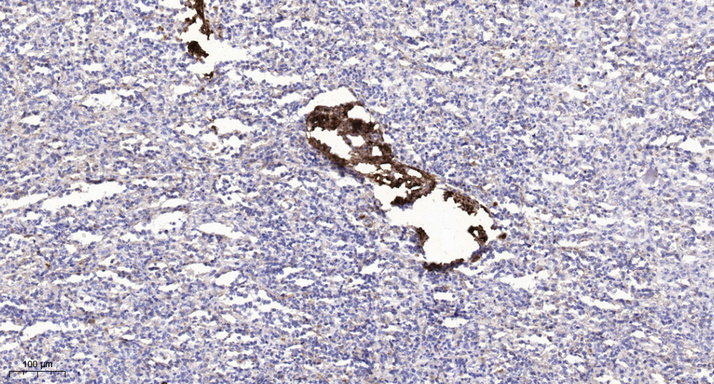- 首页
- 公司介绍
- 热门促销
-
全部产品
-
试剂盒
- |
-
一抗
- |
-
二抗
- |
-
蛋白
- |
-
免疫组化试剂
- |
-
WB 试剂
- PonceauS Staining Solution
- PBST Washing Buffer, 10X
- 1.5M Tris-HCl Buffer, pH8.8
- 1M Tris-HCl Buffer, pH6.8
- 10% SDS Solution
- Prestained Protein Marker
- TBST Washing Buffer, 10X
- SDS PAGE Loading Buffer, 5X
- Stripping Buffered Solution
- Tris Buffer, pH7.4, 10X
- Total Protein Extraction Kit
- Running Buffer, 10X
- Transfer Buffer, 10X
- 30% Acr-Bis(29:1) Solution
- Tris电泳液速溶颗粒
- PBS(1X, premixed powder)
- TBS(1X, premixed powder)
- 快速封闭液
- 转膜液速溶颗粒
- Chemical reagents
- 公司新闻
- 营销网络
- 资源中心
- 联系我们
KPB2 rabbit pAb
- 货号:YT6905
- 应用:WB;IHC
- 种属:Human;Mouse
- 简介:
- >>Calcium signaling pathway;>>Insulin signaling pathway;>>Glucagon signaling pathway
- 免疫原:
- Synthesized peptide derived from human KPB2 AA range: 911-961
- 特异性:
- This antibody detects endogenous levels of KPB2 at Human/Mouse
- 组成:
- Liquid in PBS containing 50% glycerol, 0.5% BSA and 0.02% sodium azide.
- 来源:
- Polyclonal, Rabbit,IgG
- 稀释:
- WB 1:500-2000;IHC 1:50-300
- 纯化工艺:
- The antibody was affinity-purified from rabbit antiserum by affinity-chromatography using epitope-specific immunogen.
- 储存:
- -15°C to -25°C/1 year(Do not lower than -25°C)
- 背景:
- Phosphorylase kinase is a polymer of 16 subunits, four each of alpha, beta, gamma and delta. The alpha subunit includes the skeletal muscle and hepatic isoforms, and the hepatic isoform is encoded by this gene. The beta subunit is the same in both the muscle and hepatic isoforms, and encoded by one gene. The gamma subunit also includes the skeletal muscle and hepatic isoforms, which are encoded by two different genes. The delta subunit is a calmodulin and can be encoded by three different genes. The gamma subunits contain the active site of the enzyme, whereas the alpha and beta subunits have regulatory functions controlled by phosphorylation. The delta subunit mediates the dependence of the enzyme on calcium concentration. Mutations in this gene cause glycogen storage disease type 9A, also known as X-linked liver glycogenosis. Alternatively spliced transcript variants have been reported, but the full-length nature of these variants has not been determined.[provided by RefSeq, Feb 2010],
- 功能:
- disease:Defects in PHKA2 are the cause of glycogen storage disease type 9A (GSD9A) [MIM:306000]; also known as X-linked liver glycogenosis (XLG). GSD9A is a metabolic disorder resulting in a mild glycogenosis with clinical symptoms that include hepatomegaly, growth retardation, muscle weakness, elevation of glutamate-pyruvate transaminase and glutamate-oxaloacetate transaminase, hypercholesterolemia, hypertriglyceridemia, and fasting hyperketosis. Two subtypes are known: type 1 or classic type, and type 2 or variant type. The variant type is characterized mainly by enlarged liver and growth retardation; patients do not show in vitro enzymatic deficiency of phosphorylase kinase. Unlike other glycogenosis diseases, GSD9A is generally a benign condition. Patients improve with age and are often asymptomatic as adults. Accurate diagnosis is therefore also of prognostic interest.,enzyme regula
- 细胞定位:
- Cell membrane ; Lipid-anchor ; Cytoplasmic side .
- 组织表达:
- Predominantly expressed in liver and other non-muscle tissues.

- Western blot analysis of lysates from MCF-7 cells, primary antibody was diluted at 1:1000, 4°over night

- Immunohistochemical analysis of paraffin-embedded human spleen. 1, Antibody was diluted at 1:200(4° overnight). 2, Tris-EDTA,pH9.0 was used for antigen retrieval. 3,Secondary antibody was diluted at 1:200(room temperature, 45min).





